
|
 |
 |
 |
 |
 |
| Author |
Message |
    
Natalie Severn
Inspector
Username: Severn
Post Number: 480
Registered: 11-2003
| | Posted on Friday, March 19, 2004 - 10:08 am: |       |
Thankyou Glenn.I also like E Hopper and it sounds like you paint like that.My tutor at St Martins is Royal Academician and in my view he paints like Hopper.I have been brought up in that world -my mum was a painter too.
Come on then -get going!It would be brilliant.
Natalie |
    
Glenn L Andersson
Assistant Commissioner
Username: Glenna
Post Number: 1308
Registered: 8-2003
| | Posted on Friday, March 19, 2004 - 10:29 am: |       |
Hi again, Natalie.
Seems like your painting abilities is based on very solid ground, then.
Aah... Hopper is great. When I started out, he was one of my many sources of inspirations, although my main ones were Scandinavian painters in the late 19th century.
Let me also say that I think it's refreshing to see someone doing figurative painting in a time when almost everyone in the art business is indulging in video, performance and installation art.
All the best
Ups! Sorry, guys. Back to the thread...
(Be free to e-mail me if you'd like to exchange some thoughts on art, Natalie)
Glenn Gustaf Lauritz Andersson
Crime historian, Sweden |
    
Glenn L Andersson
Assistant Commissioner
Username: Glenna
Post Number: 1309
Registered: 8-2003
| | Posted on Friday, March 19, 2004 - 11:09 am: |       |
Tommy is right about the two different interpretations of the woman's head in "The Journal".
My first impression was the one of terror or death, as I first noticed an open mouth, with something that looks like blood around her lips, and with one of the eyes staring. From that perspective, the painting gives me the creeps.
However, as been stated, one can also interpret it as a closed mouth and a shadow marking the upper part of what could be a chin. Then the picture becomes less dramatic.
The question is, if Sickert created this double meaning in the picture deliberately, or if it's just a mind illusion on the viewer's part (It could be that I've dealt with crime too long...  ). ).
Regardless of which, neither options confirms a real clue to whether he was Jack the Ripper or not. But it just shows how easy it is to find elements in a painting that don't necessarily have to mean anything significant. We all see what we want to see.
And of course, the interpretation of the pearl necklace as a metaphor for a throat that's been cut, is just ridiculous.
All the best
Glenn Gustaf Lauritz Andersson
Crime historian, Sweden |
    
Sarah Long
Chief Inspector
Username: Sarah
Post Number: 937
Registered: 11-2003
| | Posted on Friday, March 19, 2004 - 12:00 pm: |       |
Glenn,
Is this painting "The Journal" above somewhere?
Sarah |
    
Glenn L Andersson
Assistant Commissioner
Username: Glenna
Post Number: 1310
Registered: 8-2003
| | Posted on Friday, March 19, 2004 - 12:30 pm: |       |
Hi Sarah,
According to Tommy's post, it would be painting number four (counting downwards) in M.Mc's second post with pictures, the one with the woman lying down with a news-paper and the green-white striped sofa.
If you look at her face: what probably is just a chin line and a shadow, could also be interpreted as the lower lip, which makes her mouth looks like it's open, and with grinning teeth (and with something running out of her mouth). The lips are really closed but in this interpretation the upper lip instead becomes very red and unnaturally blotchy.
However, I think it's an illusion and just a mirror of the viewers own imagination. And even if Sickert intended the painting to be read both ways, it still doesen't indicate anything beyond him having a sense for the macabre.
All the best
Glenn Gustaf Lauritz Andersson
Crime historian, Sweden |
    
Alan Sharp
Chief Inspector
Username: Ash
Post Number: 533
Registered: 9-2003
| | Posted on Friday, March 19, 2004 - 12:55 pm: |       |
Just to emphasise the point, here's that Bonnard painting:
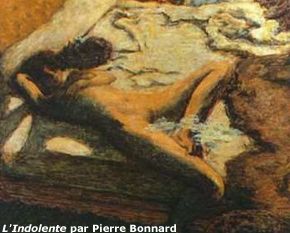
Sexually sated, or murdered? You decide.
Or how about this one:
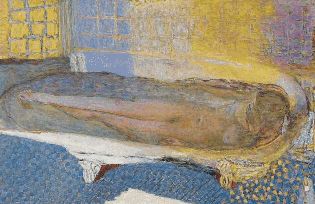
Plainly drowned, another victim of the evil Pierre Bonnard
Or here
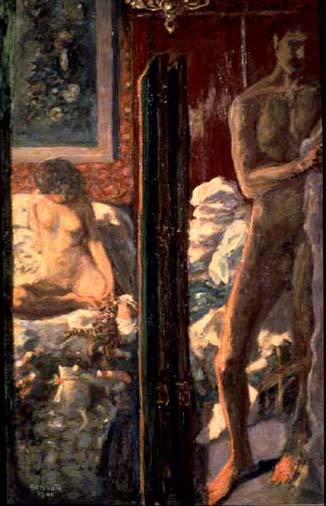
Well he's about to kill her isn't he? He's taken his clothes off so he doesn't get blood on them.
Yup, here comes my new bestselling book. Pierre Bonnard was Jack the Ripper |
    
Natalie Severn
Inspector
Username: Severn
Post Number: 484
Registered: 11-2003
| | Posted on Friday, March 19, 2004 - 2:37 pm: |       |
Hey Alan---what a sublime painter though!!!!
Natalie |
    
Glenn L Andersson
Assistant Commissioner
Username: Glenna
Post Number: 1312
Registered: 8-2003
| | Posted on Friday, March 19, 2004 - 3:13 pm: |       |
"...another victim of the evil Pierre Bonnard."
Good one, Alan
(P.S. Good luck with the book...  ) )
All the best
Glenn Gustaf Lauritz Andersson
Crime historian, Sweden |
    
Donald Souden
Inspector
Username: Supe
Post Number: 184
Registered: 10-2003
| | Posted on Friday, March 19, 2004 - 4:17 pm: |       |
Alan,
Looking at the middle picture of the trio, rather than Bonnard being the Ripper I'm starting to believe George Joseph Smith was an innocent man.
Don. |
    
ERey
Unregistered guest
| | Posted on Friday, March 19, 2004 - 1:13 pm: |       |
Alan,
Don't tell me, let me guess -- Bonnard took pains to make it look like he was in France at the time of the murders. What a devious alibi! |
    
M.Mc.
Unregistered guest
| | Posted on Friday, March 19, 2004 - 6:26 pm: |       |
Art is not only subjective but creative. To use art of any sort as "evidence" is ridicules. It's cow patties! Heck I've painted and writen stuff myself that are dark. I've never killed anyone nor do I plan on it. Just to prove this below is a rough scan of a canvas I painted myself... Sorry it's so dark but this was the best scan I could get from it. It's pretty bad, but it is good enough to make out the face. Which is my point here thank you. It's called, "Midnight in the Heather" but look at it and read what you will into it. Yes it is my art and it is of someone in the Heather at Midnight. However, nobody else sees the same thing from it. Thus I prove that art cannot be used as a "CLUE" in any crime. Not mine, not Sickert's or any artist work. Here is my art to read what you will into it...
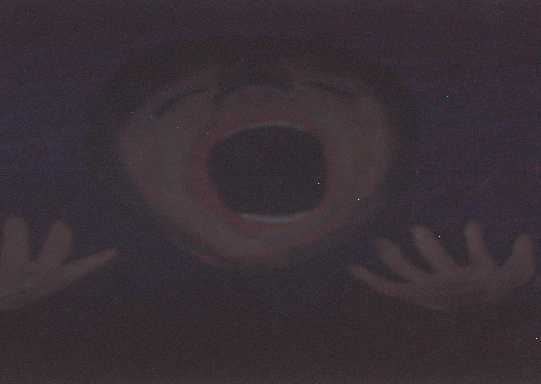 |
    
Sarah Long
Chief Inspector
Username: Sarah
Post Number: 950
Registered: 11-2003
| | Posted on Monday, March 22, 2004 - 9:23 am: |       |
M.Mc,
From what I can see it looks like a baby crying but I can't see it too well. Sorry if that's not what it's supposed to be.
Sarah |
    
Tommy Nilsson
Unregistered guest
| | Posted on Monday, March 22, 2004 - 4:48 am: |       |
Hello! I would like to point out that the more "soft" interpretation of "Le Journal", the one with a closed mouth - is the one that looks so much like the photo of Eddowes corpse in Corwells book!
Look at the mouth, the chin...but especially the ear, the red ear, terrible. No doubt in my mind that Sickert saw this, one way or another.
The photo in Cornwells book also gives some explanation to Mark Starrs questions;
Was the carpet green? No, the other paintings from Fitzroy street show no carpet in only one green colour. The green background means or shows something else.
The strange perspective in the painting may come from that photo of Eddowes. How did Sickert get hold of that photo - or was his memory of images that great? Did he make a sketch on the scene?
As I said before, Sickert was obsessed by death, murder and mutilated women. You can see this in hundreds of his work from 1886 to at least 1935.
Even what lookes like rather innocent paintings often reveals strange things if you take your time and look closely. He does a "double", one step forward (the woman is dead), one step back (she is reading a journal). If the painting is very incriminating, exhibit them in France, like "the Camden Town Murder".
This is the painter who can name his work "Puttana in Casa" (The Whore in the House). Did he like women?
Artists paint war, murder, rape and sometimes strange and dark feelings and images, but selldom all the time in fifty years!
You have to look at Sickerts work painting by painting and the compare with Bonnard...painting by painting. Yes, there is a differnce.
Regards, Tommy
|
    
Tommy Nilsson
Unregistered guest
| | Posted on Tuesday, March 23, 2004 - 6:30 am: |       |
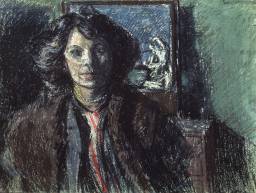
Let us take a look at one of the paintings that M. Mc. showed us earlier.
The painting is in pastel and named Mrs. Barett. There are several paintings of �Mrs. Barett�. Wendy Baron (expert on Sickerts art) beliefs that this version was painted in 1906, at a time when Sickert worked a lot in pastel. Another pastel made around the same time was named �Mrs. Barett, blackmail�.
This painting shows a middle aged, beautiful woman standing in a room with green walls. She is dressed like she is on her way out, maybe in a fur coat and she has a dress or blouse in red white stripes. She has a pearl necklace. The left side of her face is in shadow or darkness. The left side of her neck is yellow.
Behind her is a drawer. Over that drawer is a painting.
The painting has a blue background.
In the front of the painting (the right side of the woman) you can see someone in a bed, it looks like a woman with black hair, her face almost hidden in the pillow. She presses a blanket over her belly with her left arm, like she was in pain. Her legs are naked and bent in a strange way.
Behind the bed is a dressed man in a black hat. His left arm seems to reach her body.
On the right side of the painting and partly behind the drawer is a big shadow of man with a hat, you can see one of his eyes. My feeling is that of evil.
Another joke from Mr. Sickert.
Regards, Tommy
|
    
RosemaryO'Ryan
Unregistered guest
| | Posted on Tuesday, March 23, 2004 - 7:35 pm: |       |
Dear Tommy,
It is now obvious you have made up your mind vis., Mr Walter Sickert, his art, and the identity of Jack the Ripper.
Dear Mark Starr,
It is now obvious you have made up your mind vis., Mr Walter Sickert, his art, and Jack the Ripper.
Can such a mystery end in a wimper instead of the Big Bang? Is this the end of the Casebook as we know it? Ah, but then you are ONLY GUESSING! Sors! We need EVIDENCE that can be put to a jury.
Rosey :-) |
    
Sarah Long
Chief Inspector
Username: Sarah
Post Number: 984
Registered: 11-2003
| | Posted on Thursday, March 25, 2004 - 6:27 am: |       |
Tommy,
Did you completely ignore M.Mc? He just showed that artists can be dark and paint interesting things without being killers. He also said that people see many different things in art and so we cannot look at art as evidence os anything. For example I don't see anything in the painting of the woman reading the newspaper that seems evil or shows that he must have killed Kate. You would have to look into the painting so much to connect it to the murders. Sometimes people can read to much into things, for example, there was this author who wrote a book which was studied for 'A' Level English and apparently they pupils kept being asked questions like "What did the author when he wrote that the hills were dark?". Now, the author of this book was once asked this himself and he replied "because the hills were dark". There was nothing to read into at all.I know about that because I took 'A' Level English Literature and we were asked similar questions about books and poems and sometimes, I swear, there was nothing there but we still had to use our imaginations anyway.
I agree with Rosie, we need evidence. Because we all see different things in art like this it cannot be used as evidence. None of us know what Sickert was thinking when he painted these paintings.
Sarah |
    
Glenn L Andersson
Assistant Commissioner
Username: Glenna
Post Number: 1361
Registered: 8-2003
| | Posted on Thursday, March 25, 2004 - 7:41 am: |       |
Tommy wrote:
>As I said before, Sickert was obsessed by death, murder and mutilated women. You can see this in hundreds of his work from 1886 to at least 1935.
So what?
I really must congratulate you for your eminent imagination. A lot of people are interested in death and murder, even some of us here to some extent, or else we wouldn't be here. That proves nothing. Obsession is one thing. Being a serial killer is another.
I have time and time again in several posts tried to explain why we can't draw such conclusions from pieces of art. I have tried to put forward other artists indulging in similar themes (unfortunately also to no avail to everyone else here, since no one has commented on it), but nothing seems to sink in. No common sense whatsoever or knowledge of art historical facts seems to convince the "art readers" here about the ludicrous element in such ideas.
Not only does this display an ignorance about what's required as evidence when you're suspecting someone of murder, it also shows a complete lack of knowledge of how some artists work and about the influences throughout art history.
The fact that Patsy Cornball is ignorant of these matters is one thing -- she is no trained art historian, so we shouldn't be surprised -- but when people here who claim to have knowledge of art lets their fantasies lure them into such confused states of interpretation -- just because they want to see those things in the paintings -- I think we truly have hit rock bottom.
I will now sell my degree in art history to the highest bidder, since it seems worthless anyway.
All the best
Glenn Gustaf Lauritz Andersson
Crime historian, Sweden |
    
Natalie Severn
Chief Inspector
Username: Severn
Post Number: 541
Registered: 11-2003
| | Posted on Thursday, March 25, 2004 - 4:55 pm: |       |
Hi Glenn,I am in North Wales at the moment and have just looked in on the posts.I wholeheartedly agree with what you say here and have often been surprised at how many artists seem to enjoy painting gruesome stuff.I think Carravagio was a bit of a hot head and did actually commit murder.
But you are absolutely right ,there is a world of difference between fantasising about things or rather in Sickerts case using his imagination to get near a subject and understand the experience
and the actual acting out of that fantasy or work of the imagination.
Best Natalie. |
    
Glenn L Andersson
Assistant Commissioner
Username: Glenna
Post Number: 1363
Registered: 8-2003
| | Posted on Thursday, March 25, 2004 - 5:28 pm: |       |
Thank you, Natalie. 
I haven't received any bids yet, though. Apparently my education was even more worthless than I thought...
Maybe I'll keep it after all...
Have a good time in Wales.
All the best
(Message edited by Glenna on March 25, 2004)
Glenn Gustaf Lauritz Andersson
Crime historian, Sweden |
    
Natalie Severn
Chief Inspector
Username: Severn
Post Number: 543
Registered: 11-2003
| | Posted on Thursday, March 25, 2004 - 5:38 pm: |       |
Glenn,You know the line "A thing of beauty is a joy forever" the papers not important its what its given you to treasure! |
    
Tommy Nilsson
Unregistered guest
| | Posted on Thursday, March 25, 2004 - 5:48 am: |       |
Dear Rosemary,
I don�t know if it�s possible to nail anyone with hard evidence after all this time. Who has the time and resources for that? The best we can hope for is DNA or maybe fingerprints connecting someone to the Ripper letters.
I like to keep an open mind...but, yes, Walter Sickert is telling us that he was Jack the Ripper. But he was also a liar. I do believe that he wrote some of the letters. In the end I think we will prove it. Walter Sickert is a gigantic puzzle, but we are beginning to see the image, part by part. When we can connect his whereabouts, his work of art and his words - we will have an interesting picture of an artist. Walter Sickerts selfportrait.
Walter Sickert was the �Juvenile Lead�, the young genius ahead of his time, full of contempt for others. Painter, writer, journalist and teacher. The media expert, master of rumours. A concept artist, a narrative painter who painted only what he saw. A contradiction? Who wrote �I�m a master of art�?
Tommy;-)
|
    
Natalie Severn
Chief Inspector
Username: Severn
Post Number: 546
Registered: 11-2003
| | Posted on Friday, March 26, 2004 - 5:50 am: |       |
It was also the height of fashion to be like this
among bohemian groups and it was Oscar Wilde more than anyone else who cocked his snook at conventional "wisdom" and declared to a victorian customs officer,"I have Nothing to declare except my genius!"
But you are right Sickert was a trend setter all right.
|
    
Tommy Nilsson
Unregistered guest
| | Posted on Friday, March 26, 2004 - 5:40 am: |       |
I get an impression from this discussion that art doesn�t mean a thing or that work of art can mean anything and because of that you don�t need to take art seriously.
I take art seriously. I take the artist and the communication from the artist seriously, even though I know he or her may be joking. Then I laugh seriously.
I read closely what Glenn (tjena!), M. Mc. and others say about art and I respect your opinion, but I don�t agree. Not from my viewpoint as an artist and not from the viewpoint of art and picture science. There are methods and theories you can apply on work of art and it�s a science since a long time.
What is art? There are as many answers as there are people and your answer may change from time to time. I don�t think that anyone would deny that art is an expression of the artist and the artists life at a certain time and place.
Art contains information. Art is communication. Art is a language, and as a language it can be read and interpreted.
But everything can�t be interpreted, something is always left out in a complex work.
Art works on different levels. All the content in a work of art may not be known, not even to the artist. That�s a well known fact in psychology and in art science.
But this is not the say that you can�t interpret a work of art, art is a code but codes can be broken�you may not understand everything, but sometimes you can come very close.
Especially if you have if a whole body of work from an artist and the artist and his society is
well known. Then you have the opportunity to put each work into a context.
An object of art can be evidence in many ways. First, like any other object it can contain fingerprints and DNA. Second, a painting (photo, video etc) can show something from a scene of crime that only the police or the criminal could know. Third, a work of art may give a give a psychological background of the artist/suspect.
A work of art may also be a confession.
There is no logic in saying I�m a painter, I�m not a killer � painters don�t kill. Even famous artists have been known to be killers. Artist explores the dark side of human life,
mostly in their art. But there are exceptions, and Walter Sickert may be one of them.
To say that artists sublimates all of their dark emotions in art is just not true.
Regards, Tommy
|
    
M.Mc.
Unregistered guest
| | Posted on Friday, March 26, 2004 - 10:37 am: |       |
To Sarah Long, that you for agreeing with me but I'm a female not a male. The M.Mc. stands for Melissa McMahan. I get that a lot because most artist and writers are male. Like Sickert and other artist I often use short cuts for my long name. Most of the time Sickert used W.R.S but he also used W.S. or R.S. I often use M.Mc. or M.K.M. My middle name is "Kay" and sometimes I use it most often not. It beats writng out Melissa Kay McMahan for every bloody thing. Sickert and me have 3 things in common, I'm not sure that's good are not. But I'd like to point out that even though many of my paintings and writings are as dark as Sickert. The only thing I've ever killed is bugs and snakes. I doubt Sickert was the Ripper as much as I believe I never will be either. That's my point, some of my stuff is darker than Sickerts. However I can't even pick up a lost dollar off the street without wondering if someone lost it who really needed it. I have a high guilt complex over that sort of thing. If someone told me it was theirs I would hand it over even they were lying to me. I cannot speak for Sickert of course but I know how I am. |
    
Glenn L Andersson
Assistant Commissioner
Username: Glenna
Post Number: 1375
Registered: 8-2003
| | Posted on Friday, March 26, 2004 - 8:47 pm: |       |
N� men tjena, Tommy.
"I get an impression from this discussion that art doesn�t mean a thing or that work of art can mean anything and because of that you don�t need to take art seriously."
Of course art means something. The problem is that art reading also is completely subjective and the meaning of a painting lies mostly in the eyes of the beholder, unless you have clear indications from the artist himself (or herself) about the intention.
I am not saying that art can't tell us anything (I wouldn't be a Bachelor of Art, if I felt that), but in police matters and especially in a murder investigation art is completely useless.
And that is why I don't feel that art history or art interpretation is a science. It is a university subject and there has been made some rather lame attempts to apply psychological theories in connection with it, but in my view it doesen't stand up to real scientific demands and standards.
Yes, codes of art can be broken, but that is a act of subjective analysis just the same. You can't regard anything subjective as evidence of any kind. That is not how it works, and certainly not in a police investigation.
No, a piece of art can't be a accepted as true evidence or a confession. Even if the artist in question has clearly testified on it (either on a document or written it in connection with the actual painting), you can't know if it's just in the artist's own head (as a fantasy) or if it's a real confession. Have you any idea how many false confessions that's pouring in during a normal murder investigation on a larger scale? A confession in itself isn't enough; it must be corroborated by physical evidence. Here we don't even have credible speculations, based on reliable facts -- only guesswork and personal interpretations. That won't do.
"There is no logic in saying I�m a painter, I�m not a killer � painters don�t kill."
And there is no logic in saying "I am a painter; my pictures are dark and macabre -- therefore I am a killer".
"To say that artists sublimates all of their dark emotions in art is just not true."
Yes, it is. Art worked as a therapy for rather disturbed painters like Edvard Munch and Vincent van Gogh, to name the most famous ones, and they were hardly murderers. And I must say I cant really see what's so extraordinary about Sickert in that regard.
There are apparently a lot of artists that have or do show psychopathic personality traits (and I can't exclude the possibility that Sickert was one), but a psychopath doesne't have to be a murderer.
All the best
Glenn Gustaf Lauritz Andersson
Crime historian, Sweden |
|
Use of these
message boards implies agreement and consent to our Terms of Use.
The views expressed here in no way reflect the views of the owners and
operators of Casebook: Jack the Ripper.
Our old message board content (45,000+ messages) is no longer available online, but a complete archive
is available on the Casebook At Home Edition, for 19.99 (US) plus shipping.
The "At Home" Edition works just like the real web site, but with absolutely no advertisements.
You can browse it anywhere - in the car, on the plane, on your front porch - without ever needing to hook up to
an internet connection. Click here to buy the Casebook At Home Edition.

|
 |
 |
|
 ).
). 





